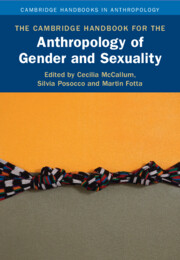Book contents
- The Cambridge Handbook for the Anthropology of Gender and Sexuality
- Cambridge Handbooks in Anthropology
- The Cambridge Handbook for the Anthropology of Gender and Sexuality
- Copyright page
- Contents
- Contributors
- 1 Introduction to The Cambridge Handbook for the Anthropology of Gender and Sexuality
- Part One Openings and Orientations
- Part Two Knowledges and Domains
- Part Three Resistances and Intersections
- Part Four Desires and Relations
- 18 Subjectivities, Knowledge, and Gendered and Sexual Transitions
- 19 Feminist and Queer Theories of the Non/Human and Paradoxical Possibilities of the Slash
- 20 Blood, Gender, and Politics in Indigenous View
- 21 “At Home” in Botox, Feminism, and Ethics
- Part Five Recursivities and Futures
- Name Index
- Subject Index
- References
20 - Blood, Gender, and Politics in Indigenous View
from Part Four - Desires and Relations
Published online by Cambridge University Press: 29 September 2023
- The Cambridge Handbook for the Anthropology of Gender and Sexuality
- Cambridge Handbooks in Anthropology
- The Cambridge Handbook for the Anthropology of Gender and Sexuality
- Copyright page
- Contents
- Contributors
- 1 Introduction to The Cambridge Handbook for the Anthropology of Gender and Sexuality
- Part One Openings and Orientations
- Part Two Knowledges and Domains
- Part Three Resistances and Intersections
- Part Four Desires and Relations
- 18 Subjectivities, Knowledge, and Gendered and Sexual Transitions
- 19 Feminist and Queer Theories of the Non/Human and Paradoxical Possibilities of the Slash
- 20 Blood, Gender, and Politics in Indigenous View
- 21 “At Home” in Botox, Feminism, and Ethics
- Part Five Recursivities and Futures
- Name Index
- Subject Index
- References
Summary
A historical account of the key debates and ethnographies about Amerindian gender, politics, and social life would tell a story of how, in the anthropology of the region, the focus shifted from “society” to “sociality,” from models of kinship to the body to socio-cosmology, and from an epistemological concern with “social representations” to a firm gaze on “Indigenous ontologies” and “cosmopolitics.” This story is told, in part, in this chapter. But the main concern is to shift the gaze and explore Indigenous South American women’s understanding of the integral links between gender, sexuality, and land by highlighting the emerging narratives of a new generation of Amerindian female intellectuals, leaders, and activists, who have learned to use academic language to speak about their own people’s knowledge. Many choose to study rituals they have personally experienced, such as female bodily practices, childbirth, and menstrual seclusion, since in their understanding, body flows create memory and connect to a body-territory, which, in turn, sustains women’s strength and involvement in the current politics of land. Thus, the chapter provides an account of the intersections between their work and that coming from Amerindian ethnology, feminism, and queer anthropology.
Keywords
- Type
- Chapter
- Information
- Publisher: Cambridge University PressPrint publication year: 2023



